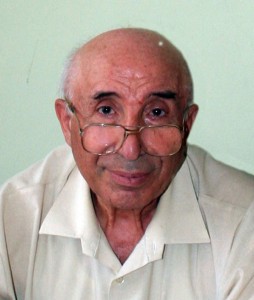ARMENIAN 2100 YEARS OLD GLORY
 Interview with Babken Harutyunyan, Dr. of Historical Sciences
Interview with Babken Harutyunyan, Dr. of Historical Sciences
-Mr. Harutyunyan, Tigran the Great is a symbol of power, heroism, patriotism and glory, as well as historical dreams for the Armenians. Recently we celebrated 2105 anniversary of Tigran the Great’s enthronement. Let’s take the opportunity and ask you to represent the life and the military achievements of our glorious king.
-Until Tigran the Great’s enthronement and after it, attempts have been made to form an Armenian country. However, only he was able to form an Armenian powerful country. According to the reports of primary sources Tigran the Great was born in 140 BC. He came from the royal family of the Artashesyans. The Armenian king Artavazd had to give his nephew- Tigran to the partevs as a hostage during one of the invasions of the partevs. Tigran was brought up and he reached virility in the palace of the partevs. He was a hostage till the age of 45. After the death of king Artavazd, Tigran returned to Armenia. He came to the throne in 95 BC and had to make considerable compromises to get a permission to return to his fatherland. Tigran gave the partevs the seventy valleys that king Artashes had once captured from the mars. When Tigran came to the throne, unfortunately, Armenia wasn’t a united country and consisted of three kingdoms – Greater Armenia, Armenia Minor and Tsopk. It could perhaps be considered that Tigran could hardly have any further plans and aims when coming to Armenia, but he found a country with great potential and he could solve serious problems.
-Can you describe Tigran the Great’s country when it was on the top of its glory? How much territory did it occupy? What administrative political structure did it have?
-Tigran the Great’s country occupied one million square miles and there were Armenian garrisons everywhere. The real Armenian territory consisted of more than 100 provinces which were governed by provincial lords. The Armenian country included a number of kingdoms such as Virk and Aghvank, Atrpatakan and so on. Tigran had married his daughter to king Mihridates of Atrpatakan. But other kings were also subject to Armenian state and there were no garrison in their territories. Tigran the Great took the state of partevs, the kingdoms of Karakene and Elyumayis under his political influence. The kingdoms of Karaken and Elyumayis made an alliance with the Arabic tribes settled at the coasts of the Persian Gulf and the tribes settled at the basin of the Amudaria River in the Middle Asia. These tribes took part in the battle of Tigranakert. It’s necessary to mention that Tigran the Great temporarily conquered the empire of Kapadovkia and entrusted it to his relative Gordios who had one presented the pontic delegation in Armenian-Pontic negotiations in person. He also entrusted him Gaghatia. Let’s not forget that Pontus with its subjugated countries was the ally of Tigran the Great. The kingdom of Egypt appeared in the political interests of the Armenian kingdom. The Armenian king enthroned Ptolemy XII in Egypt.
Asorik formed a part of Armenian where the Armenia viceroy realized executive power- and northern Mijagetk which had turned into a province of the territory was given to the rule of the king’s brother – Guras. With the lands of the territory and with the influenced countries and tribal countries, Tigran the Great controlled a territory of no less than three million square kilometers.
It must be mentioned that the Armenian powerful state was, of course, a guarantee not only for the development of forming and economics, but also for the development of town building and cultural development. During that period particularly town building made its run. Tigranakert and other numerous cities, which bore the name of the king, were built.
-Can you describe Tigran the Great’s armed forces, infantry, heavy cavalry, spearmen, archers and so on?
-The structural faults of the Eastern army which made themselves felt especially in the battle of Tigranakert, where the Armenian numerous troops collided with the Roman army and its allies, were also typical to Tigran the Great’s army. The army was also formed on the ethnic principle which made it hard to rule. We must take into consideration that the armies of captured and vassal territories with their military leaders took part in military actions and it wasn’t always possible to coordinate their actions. After the battle of Tigranakert, Tigran the Great’s army underwent transformations. The number of the troops was reduced and the army was trained with the standards of the military art of the Roman army. It became efficient and easy to rule.
-Mr. Harutyunyan how does the European historical science present Tigran the Great’s Armenia and the King of the Kings.
-It must be mentioned that Tigran the Great’s image and his work are rather belittled in the west. A few mention Eupator’s name as a chief leader exaggerating his role and authority and presenting Tigran the Great as a tool in the hands of Mihridates VI. Antique authors have spared no effort to distort the image of Tigran the Great. Unfortunately the Armenian historical science hasn’t done justice to Tigran the Great being indifferent to the work of the great Armenian king for a long time. H. Manandyan’s efforts ended the indifference. And serious work has recently been done by the doctor of historical sciences R. Manaseryan and assistant professor H. Hakobyan to increase the significance of Tigran the Great’s state. We can talk about the image of Tigran the Great for a long time, but it’s a topic of a separate article. I think that the image of the King of the Kings must be presented to the Armenian soldier with all its heroism and military talent, becoming a model for the Armenian military forces. Various publications, series of articles and essays both on public and scientific levels are necessary for it.
Category: Pages of History










